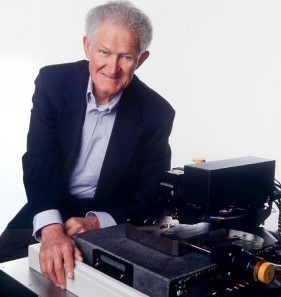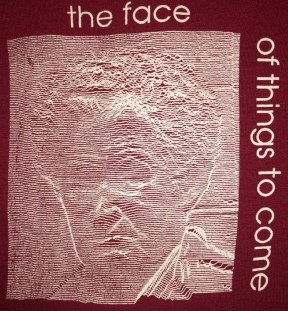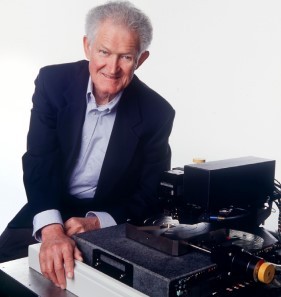A Tribute to Dr. Calvin Quate (1923–2019)
- 21 Aug 2019
- Volume 17
- NanoScientific Magazine, Summer 2019

My Memories of Dr. Quate
Franz J. Giessibl

Franz J. Giessibl currently works at the Institute of Experimental and Applied Physics, University Regensburg where he does research in Condensed Matter Physics, Experimental Physics, Electronics and Mechanics.
It is impossible to forget the first time I met Calvin Forrest Quate. It happened at the Scanning Tunneling Microscopy conference at the University of Oxford in 1988, where a group of students from Stanford University wore red sweatshirts that showed the face of a man in raster lines, with "the face of things to come" written on them.

I had just started to work on my PhD thesis with Gerd Binnig, who won the 1986 Nobel Prize in Physics together with Heini Rohrer for the invention of the scanning tunneling microscope (STM). STM was introduced at a time where personal computers and computer graphics were rudimentary at best. Accordingly, images were recorded trace by trace on chart recorders and a face was printed on the sweatshirts in that style. I wondered, "Who is this man, pictured on these shirts?“ The face showed Calvin Forrest Quate, Edward Leland professor for Electrical Engineering and Applied Physics at Stanford University, born Dec 7, 1923. Professor Quate had been working on microwave technology and electron beam interactions at Bell Labs, and was a vice president and director of research at Sandia Labs before joining Stanford. At Stanford, he did pioneering work in microwave acoustics and introduced the acoustic microscope. At the age of almost sixty, he learned about vacuum tunneling and its potential use for microscopy on a flight to Europe. Professor Quate was on his way to a conference in London and extended his itinerary by a visit to the IBM Research Laboratory in Zurich to learn about scanning tunneling microscopy first hand (1). Calvin Quate ended his talk at the 1988 conference on STM discussing the many possibilities of scanning probe microscopy (SPM). I introduced myself and asked whether his ending about the perspective of SPM related to a magic chestful of endless possibilities, which he acknowledged with a witting smile.
He asked about the project I was working on, and immediately offered that I call him "Cal". After Binnig had applied for a patent for the atomic force microscope (AFM) in 1985, an extension of STM that should also be able to image insulators at very high resolution, Gerd Binnig, Calvin F. Quate and Christoph Gerber set out to build an AFM and published a seminal paper in Physical Review Letters (2) about it. Cal realized that the cantilever of AFM that probes the forces between its tip and the sample was essential to the performance of the new microscope and set up a program to design micromachined cantilevers made from SiO2 , Si3 N4 and later Si in the Stanford micromachining facilities. He supplied these cantilevers to our Munich IBM group that was started by Gerd Binnig and Christoph Gerber in 1987 were I became a member in 1988. After having obtained a PhD with Gerd, I joined Park Scientific Instruments (PSI), a company that was founded by Cal’s former student Sang-il Park with Calvin Quate on the board of directors. While AFM at that time was mostly used in ambient conditions to image all types of samples on the nanometer scale, achieving atomic resolution in vacuum similar to STM was still not possible. My project at PSI was to design a room temperature UHV microscope that utilized the piezoresistive cantilevers that were invented in Cal’s group. This microscope achieved atomic resolution on the reconstructed surface of Si(111)-(7x7), a feat that was important because atomic imaging of this surface by STM introduced this instrument into the toolbox of the thriving field of surface science. Cal frequently visited PSI - he had his way of looking deep into your eyes expressing his confidence in students and coworkers by gently saying, "you can do it“.
He also supported me in publishing the successful imaging of Si(111)-(7x7) in Science in 1995. During a visit of Cal in my new affiliation at Jochen Mannharts chair at the University of Augsburg (Germany), Cal suggested to study graphite with our newly built low temperature AFM. Graphite was widely used in ambient STM and allowed even beginners to achieve atomic resolution easily, while exposing a few miracles such as giant corrugations and the appearance of only one of the two atoms per unit cell in the STM images. Cal was enthusiastically contributing to the joint papers, writing in an email in 2006 "Wonderful stuff Franz. Thanks for including me. I have gotten a lot of mileage from the article by showing it to people who assumed that I was over the hill“.
The engineer in Cal always loved applications - I remember I once met Cal on the weekend in Fry’s Electronics, a large electronic outlet, where he was looking at the new gadgets that had made it from laboratory to market to be inspired by them and spur his imagination. The visionary in Cal was a man who looked for progress in many places. He hired students from all over the world and interacted intensively with physicists, engineers, chemists, mathematicians and computer scientists. In his spare time, he loved to hike in nature with his students.
Cal passed away in his home in Menlo Park on July 6 2019 (3). His love for science and engineering radiated to many of his students and coworkers, and his gentle and humble ways made it natural for them to return this respect and admiration. When the Kavli Prize for Nanoscience was awarded to Gerd Binnig, Christoph Gerber and Calvin Quate in 2016, about a dozen of his former students and associates joined the ceremony in Oslo - a quarter of a century after their graduation. Calvin Quate received multiple other honors, including the IEEE Medal of Honor, the United States National Medal of Science, the Joseph F. Keithley Award For Advances in Measurement Science and others and was a member of both the National Academy of Sciences and the National Academy of Engineering.
His former students became officers and researchers in large Silicon Valley corporations such as IBM, KLA-Tencor and others. One of his former students founded a leading AFM company, one managed the US research station on the South Pole, some others became professors at distinguished universities around the world.
Cal is deeply missed, but he left a rich legacy.
1. Vacuum Tunneling: A New Technique for Microscopy, Calvin F. Quate, Physics Today 39(8), 26 (1986); https://doi.org/10.1063/1.881071
2. Atomic Force Microscope, G. Binnig, C.F. Quate, Ch. Gerber, Phys. Rev. Lett. 56, 930 (1986).
3. Calvin F. Quate, inventor of advanced microscopes, dies at 95, Andrew Myers,https://news.stanford.edu/2019/07/10/calvin-f-quate-inventoradvanced-microscopes-dies-95/
4.Photo by Thomas Albrecht, linescan rendering by Sang-il Park.
